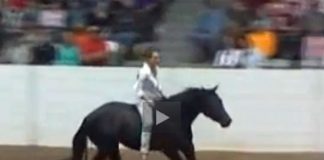Q: When I ask my reining horse to do large, fast circles, he takes off and I can barely slow him down. How do I get back control?

If acceleration makes your heart race, you may stiffen your body or brace against the stirrups when your horse picks up the pace. These responses transmit your anxiety to your horse, increase his stress, and make him go faster. Practice breathing deeply while you ride. Imagine every inhalation is being drawn down into your heels. As you exhale consciously, release tension in your body or hands. Be aware of your riding position as well. Ear-shoulder-hip-heel alignment helps your horse stay balanced, and balance is essential for a relaxed and steady gait.
How you hold the reins is important too. Deliberately hold them softly with half-open fingers. Carry your hands in front of the saddle just below the saddle horn. Be aware of your hands when your horse accelerates, whether in response to your cue or on his own. If you inadvertently grab or pull to feel more secure, he will lock his jaw and run through the bit.
Establish new habits and rebuild his confidence by riding within your comfort zone and his, even if that means putting large, fast circles, or the lope itself, on the back burner for a while.
How to Build your horse’s Confidence
In a snaffle or low-leverage loose-shank curb, ride with two hands on the reins. Hold your hands wider than your hips. Ask your horse to move forward in a relaxed frame at the walk, extended jog, and long-trot. Make soft contact with his mouth, relax your pelvis, and gently encourage your horse to step under his body with his hind legs. Follow the movement of his head and neck.
Next, add lateral work to increase your horse’s balance and controllability. Ride with light and even rein contact. Keeping your horse’s neck nearly straight, flex his head one inch toward the outside of a straight or curved track. Open the door for him to move toward the inside of the track by moving your inside leg forward and away from his side. Cue him to step sideways with rhythmic pressure with your outside leg in the center of his ribcage. This exercise can be performed at any gait but should be taught at the walk and practiced at the trot before moving on to the lope (ask him to move in the direction of his leading leg).
Last but not least, add trot-lope-trot transitions. Lope briefly—no more than two circles, or fewer if your horse tenses or rushes—before returning to the trot. Take frequent walk breaks on a loose rein to further reinforce your horse’s calm state of mind. As your horse becomes more comfortable, spend more time at the lope. Then gradually extend his stride and increase his tempo until he’s circling at the desired pace.
This article originally appeared in the November 2011 issue of Horse Illustrated magazine. Click here to subscribe!





